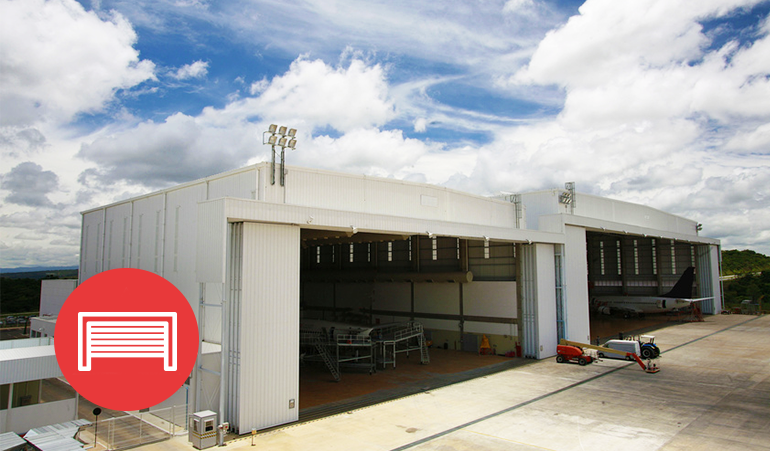Last updated on February 11th 2021.
Unless you have physically dealt with poorly maintained, low quality, or just ‘bad’ hangar doors, it is hard to fully appreciate how little you notice them when they are good. Airplane hangar doors are made in a variety of different configurations, for different reasons. Some configurations are designed for strength, some for ease of use, and even others are made to handle specific environmental features in a given climate. Here’s an overview.
Hangar doors are that important to the hangar
Hangar doors have three distinct purposes. First, they serve to keep the elements out. Second, they keep climatized air in. Third, they control the entry of varmints, vermin, and birds. All three of these are of equal importance, although not all types perform each task as well as the next.
In order to be effective,hangar doors must have good sealing qualities on all sides of the door. Second, they must, absolutely must, be durable. Third (first on the list depending on the climate), they have to be easy to open. At first glance it appears that they are little more than a barrier between the sanctuary of the hangar interior and the harsh elements outside, and this is not untrue.
Different types of hangar doors: The pros and cons
There is a surprisingly wide array of different types and styles of hangar doors. Some are traditional and time-tested, while other styles utilizemodern hydraulic systems to swing the entire door.
|
Type of door |
Pros |
Cons |
|
Hydraulic swinging |
Allows for great headspace OR lower initial build height. |
It is basically a huge sail when open, moderate maintenance. |
|
Bi-fold |
Convenient, motorized. |
Requires a much taller hangar than necessary to clear the aircraft. |
|
Bottom rolling |
Extremely heavy duty, low maintenance. |
Extremely heavy, rails must be set in footings, prone to jams on the rails. |
Bottom rolling hangar doors
Personal experience has taught us that bottom rolling hangar doors are best suited for very large applications, as in single-aisle passenger jets and larger. These hangars are routinely so tall that a lifted-type door is absolutely not an option because of shear weight (bottom rolling doors weigh many tons per unit, far beyond the ability of hydraulics actuators to lift).Bottom rolling doors are low maintenance, particularly if they are an unpowered unit since there is little that can go wrong with this type of doors. Powered bottom rolling doors are probably the simplest of powered or assisted units with a large electric motor powering the drive wheel by use of simple direct chain drive.
Hydraulic swinging hangar doors
Hydraulic swinging doors have excellent potential. The concept is simple: the entire door assembly is raised from a vertical (closed) position to horizontal (fully open). A critical feature of these types of doors is that they must be relatively lightweight; it takes a lot of hydraulic pressure to raise a door in this manner so weight has to be kept to a minimum. While the manufacturers of these doors do not specifically state this, it stands to reason that these hangar doors are best used in environments which do not experience chronic high winds. Hydraulic swinging doors lift the door on pivots so when it is open, it is not pulled into the hangar like a garage door, but is instead fully exposed and high winds would certainly wreak havoc.
Bi-folding hangar doors
Bi-folding doors have been on the market for many years and work quite well. They are not well suited for business aircraft and are best served for general aviation because they are not efficient with vertical space. However, they are much lower maintenance than a hydraulic system by using heavy nylon straps or steel cables to winch the door open. The major benefit of this design is ease of operation with a lower price than a hydraulic system.
It was brought to our attention by Diamond Doors that a bi-fold door does not require a larger building size; a steel structured building would require the larger building, but if the building is of wooded composition, i.e., pole barn style, the door can be mounted on the exterior and will not affect the height of the building. In fact, there is the ability to add a self-supporting header which affords the ability to open up entire walls, which is then mounted to the exterior of the building and anchored into the building’s foundation.
Kudos to the fine people of Diamond Doors for bringing that to our attention and explaining this detail.
Knowing which hangar door is right for you
The first item of consideration in determining the right door for you is understanding the application. Are you building a new hangar or retrofitting an old hangar?
Or is it a direct replacement of a worn out system on an old hangar?
Unpowered sliding hangar doors are common in older hangars, even small units.
When a sliding hangar door is due for replacement, bi-folding or hydraulic swinging doors are an attractive replacement option because of the structural repairs which are likely to be necessary, like replacing the tracks and footings which the door rides on. Those repairs are not cheap, and those styles of doors are not very user-friendly. Retrofitting an older hangar with a powered unit is an excellent consideration.
As previously mentioned, sometimes there are no other options. Powered sliding hangar doors are the only option for large aircraft hangars and owners of those must plan accordingly. If a hangar owner is building a new hangar for small and medium-sized aircraft, the hydraulic swing doors are a very attractive option. They are virtually silent, require only a single person to operate (making the entire operation doable by one person), and are built out of steel for years of durability.>
Hangar doors on a budget
Bi-fold doors are an economical alternative to hydraulic swinging doors. They allow owners to easily operate the door alone, and are efficient, but given the choice between the two types the hydraulic swinging system is much more robust. Of course, there are always trade offs. Hydraulic systems are expensive, whereas nylon straps and an electric winch motor are inexpensive. If cost is a prime consideration this is probably the better option, assuming your hangar has the headroom available to support bi-fold since the design will reduce available headroom from a sliding-type door.
Speaking from past experience, and meaning no harm to manufacturers of sliding doors, but sliding doors are the weakest about sealing out pests and birds, and sealing in climate controlled air. This is inherent to the design;overlapping doors and seals seldom seem to work very well whereas either of the hanging doors have only three points to seal: both edges and the ground. In terms of environmental control and pest prohibition, they are clearly superior.
Useful tips for your next investment
Your airplane and ground support equipment are not the only items which need servicing; conducting regular preventative maintenance (PM) on your hangar door will help it work better, last longer, and protect your other assets with more integrity. Also, PMs on the hangar door are a lot cheaper than the damage which can befall your aircraft if it is unserviceable.
Keep a grease gun around with an approved grease and hit the zircs a few times every year. This will greatly prolong the life of the components, regardless of what style of door. Also, keep the exterior clear by use of a pressure washer with hot water and soap, and keep decent paint on it. If your hangar door is a sliding unit, make sure to keep the rails clean and free from built of dirt and aggregate. A long compressed air wand works very well for this, as does a pressure washer. Also, make sure there are no bird nests located on the top rails for sliding doors.
Conclusion to airplane hangar doors
Airplane hangars are a major investment, and the door is probably overlooked in the equation. Without a solid, reliable door, your business is losing valuable time and accessibility. Hangar doors are not only the access point to your aircraft, but they are a primary active safety measure to ensure the protection of your aircraft and associated equipment (tugs, power units, etc.). Ensuring that you are using the right door, and taking care of the door you already have, are foundational to the success and longevity of your operations.
Hangar doors play one of many important roles in everyday hangar business. Take a look at our free eBook for even more tips on safe and efficient ground handling right here:



Comments